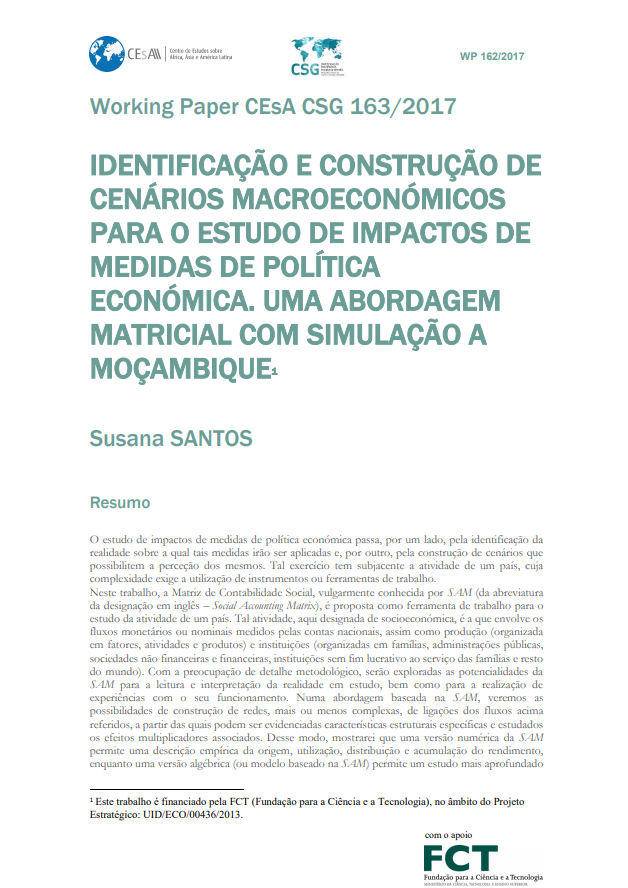Development Economics and Policy

Working Paper 163/2017: Identificação e Construção de Cenários Macroeconómicos para o Estudo de Impactos de Medidas de Política Económica. Uma abordagem matricial com simulação a Moçambique
Abstract:
The study of the impacts of economic policy measures involves, on the one hand, the identification of the reality on which such measures will be applied and, on the other hand, the construction of scenarios that allow their perception. This exercise is based on the activity of a country, whose complexity requires the use of instruments or work tools. Identificação e Construção de Cenários Macroeconómicos para o Estudo de Impactos de Medidas de Política Económica. Uma abordagem matricial com simulação a Moçambique, the Social Accounting Matrix, commonly known as SAM (from the abbreviation of the name in English – Social Accounting Matrix), is proposed as a working tool for the study of the activity of a country. Such activity, here designated as socio-economic, involves monetary or nominal flows measured by national accounts, as well as production (organized into factors, activities and products) and institutions (organized into households, public administrations, non-financial and financial corporations, non-profit institutions serving families and the rest of the world). With a concern for methodological detail, the potential of SAM will be explored for the reading and interpretation of the reality under study, as well as for carrying out experiments with its operation. In an approach based on SAM, we will see the possibilities of building networks, more or less complex, of connections of the flows mentioned above, from which specific structural characteristics can be highlighted and the associated multiplier effects studied. In this way, I will show that a numerical version of the SAM allows an empirical description of the origin, use, distribution and accumulation of income, while an algebraic version (or model based on the SAM) allows for a more in-depth study of the multiplier effects (or impacts) associated with changes in these flows, caused by the adoption of policy measures, for example. I will exemplify such potentialities of SAM, giving special attention to the functional and institutional distribution of income, through the construction and analysis of two scenarios involving changes in the remuneration of production factors and in the income of institutions. Such an application will allow the identification of the relevant role of production factor accounts (from SAM), as they establish the link between income generation and the corresponding distribution and use. I will also emphasize the importance of a matrix approach in the identification and construction of macroeconomic scenarios in the study of impacts of economic policy measures, highlighting the complementary details that an InputOutput Matrix (IOM) can add. An application to the case of Mozambique in 2015 will accompany the presentation. In this application we will often talk about simulation due to the unavailability of information regarding all the flows worked.
Quotation:
Santos, Susana (2017). “Identificação e construção de cenários macroeconómicos para o estudo de impactos de medidas de política económica. Uma abordagem matricial com simulação a Moçambique”. Instituto Superior de Economia e Gestão – CEsA/ CSG – Documentos de Trabalho nº 163/2017.





